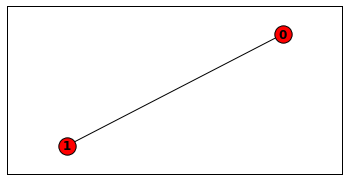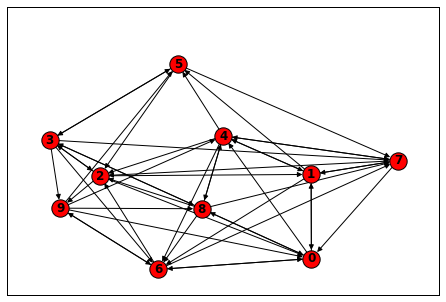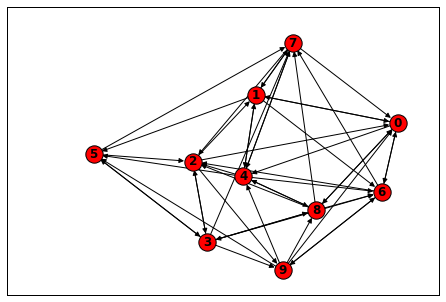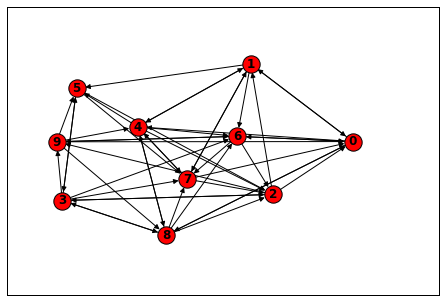小书匠
Graph
图论
学过线性代数的都了解矩阵,在矩阵上的文章可做的很多,什么特征矩阵,单位矩阵等.grpah存储可以使用矩阵,比如graph的
邻接矩阵
,
权重矩阵
等,这节主要是在等到graph后,如何快速得到这些信息.详细官方文档在
这里
12.graph和其他数据格式转换
12.1graph与字典(Dict)
12.2graph与列表(List)
12.3graph与numpy
12.4graph与Scipy
12.5graph与Pandas
12.1graph与字典(Dict)
-
-
dod = {
0
: {
1
: {
'weight'
:
1
}}}
-
G = nx.from_dict_of_dicts(dod)
-
plt.subplots(
1
,
1
,figsize=(
6
,
3
))
-
nx.draw(G, with_labels=
True
, font_weight=
'bold'
)
-
plt.axis(
'on'
)
-
plt.xticks([])
-
plt.yticks([])
-
plt.show()
-
-
-
print(nx.to_dict_of_dicts(G))

graph与字典(Dict)示例
{0: {1: {'weight': 1}}, 1: {0: {'weight': 1}}}
12.2graph与列表(List)
-
-
dol = {
0
: [
1
,
2
,
3
]}
-
edgelist = [(
0
,
1
),(
0
,
3
),(
2
,
3
)]
-
-
G1 = nx.from_dict_of_lists(dol)
-
G2=nx.from_edgelist(edgelist)
-
-
-
plt.subplots(
1
,
2
,figsize=(
15
,
3
))
-
plt.subplot(
121
)
-
nx.draw(G1, with_labels=
True
, font_weight=
'bold'
)
-
plt.axis(
'on'
)
-
plt.xticks([])
-
plt.yticks([])
-
plt.subplot(
122
)
-
nx.draw(G2, with_labels=
True
, font_weight=
'bold'
)
-
plt.axis(
'on'
)
-
plt.xticks([])
-
plt.yticks([])
-
plt.show()
-
-
-
print(nx.to_dict_of_lists(G1))
-
print(nx.to_edgelist(G1))

graph与列表(List)示例
{0: [1, 2, 3], 1: [0], 2: [0], 3: [0]}
[(0, 1, {}), (0, 2, {}), (0, 3, {})]
12.3graph与numpy
-
-
import
numpy
as
np
-
a = np.reshape(np.random.random_integers(
0
,
1
, size=
100
), (
10
,
10
))
-
D = nx.DiGraph(a)
-
nx.draw(D, with_labels=
True
, font_weight=
'bold'
)
-
plt.axis(
'on'
)
-
plt.xticks([])
-
plt.yticks([])
-
plt.show()
-
-
-
G=nx.Graph()
-
G.add_edge(
1
,
2
, weight=
7.0
, cost=
5
)
-
A1 = nx.to_numpy_matrix(G)
-
A2 = nx.to_numpy_recarray(G, dtype=[(
'weight'
, float), (
'cost'
, int)])
-
print(A1,A2)

graph与numpy示例
-
[[0. 7.]
-
[7. 0.]] [[(0., 0) (7., 5)]
-
[(7., 5) (0., 0)]]
12.4graph与Scipy
-
-
G.clear()
-
import
scipy
as
sp
-
A = sp.sparse.eye(
2
,
2
,
1
)
-
G = nx.from_scipy_sparse_matrix(A)
-
nx.draw(D, with_labels=
True
, font_weight=
'bold'
)
-
plt.axis(
'on'
)
-
plt.xticks([])
-
plt.yticks([])
-
plt.show()
-
-
-
A = nx.to_scipy_sparse_matrix(G)
-
print(A.todense())

graph与Scipy示例
12.5graph与Pandas
-
-
G.clear()
-
import
pandas
as
pd
-
df = pd.DataFrame([[
1
,
1
], [
2
,
1
]])
-
G = nx.from_pandas_adjacency(df)
-
nx.draw(D, with_labels=
True
, font_weight=
'bold'
)
-
plt.axis(
'on'
)
-
plt.xticks([])
-
plt.yticks([])
-
plt.show()
-
-
-
df = nx.to_pandas_adjacency(G)
-
print(df)

graph与Pandas示例




